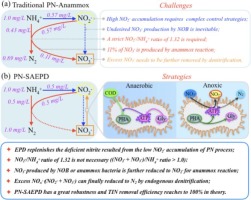Water Research ( IF 11.4 ) Pub Date : 2020-03-04 , DOI: 10.1016/j.watres.2020.115690 Jiantao Ji , Yongzhen Peng , Xiyao Li , Qiong Zhang , Xiping Liu

|
Mainstream anammox still faces the challenges of non-ideal NO2-/NH4+ ratios and excess nitrate resulted from the instability of partial nitrification (PN) in municipal wastewater. To address these problems, in this study, we developed a novel two-sludge process that combined PN with synchronous anammox and endogenous partial denitrification (SAEPD); the process was tested with pre-treated domestic sewage at ambient temperatures for 205 d. High nitrogen removal efficiency of 91.2% was achieved with an influent C/N ratio of 1.7 at 15.4 °C; the success was attributed to the fact that EPD replenished the deficient nitrite by reducing nitrate and the excess nitrite was further reduced to nitrogen gas. With a non-ideal NO2-/NH4+ ratio of 0.89, the contribution of the SAEPD-sequencing batch reactor (SBR) during the anoxic stage reached 98.2% and the proportional contributions of the anammox and denitrification pathways were 77.2% and 22.8%, respectively. Although the low nitrite accumulation (66.1%) caused 10.8 mg N/L of nitrate to be transported into the SAEPD-SBR and the anammox reaction also converted 20% of nitrite to nitrate, only 1.1 mg N/L of nitrate remained in the effluent. High-throughput sequencing analysis revealed that although NH2OH was added, some genera of nitrite-oxidizing bacteria (0.73%) remained in the PN-SBR and potentially resulted in the oxidation of nitrite to nitrate. In the SAEPD-SBR, anammox and endogenous denitrifying bacteria co-existed and synergistically achieved the removal of ammonium, nitrite, and nitrate. Overall, the PN-SAEPD process has great potential for achieving cost-effective and energy-efficient municipal wastewater treatment.
中文翻译:

一种新型的部分硝化-同步厌氧氨氧化和内源性部分反硝化(PN-SAEPD)工艺,用于在环境温度下高级去除城市污水中的氮
厌氧氨氧化主流仍面临非理想NO的挑战2 - / NH 4 +的比率和过量的硝酸导致从市政污水局部硝化(PN)的不稳定性。为了解决这些问题,在这项研究中,我们开发了一种新型的二污泥工艺,该工艺将PN与同步厌氧氨水和内源性部分反硝化(SAEPD)相结合。该过程在环境温度下用预处理的生活污水测试了205天。在15.4°C下进水C / N比为1.7时,实现了91.2%的高脱氮效率;该成功归因于以下事实:EPD通过还原硝酸盐来补充不足的亚硝酸盐,并将过量的亚硝酸盐进一步还原为氮气。与非理想的NO 2 - / NH4 +比率为0.89,在缺氧阶段SAEPD测序间歇反应器(SBR)的贡献达到98.2%,厌氧氨氧化和反硝化途径的比例贡献分别为77.2%和22.8%。尽管亚硝酸盐的低累积量(66.1%)导致将10.8 mg N / L的硝酸盐运输到SAEPD-SBR中,并且厌氧氨氧化反应也将20%的亚硝酸盐转化为硝酸盐,但废水中仅残留1.1 mg N / L的硝酸盐。高通量测序分析表明,尽管NH 2加入OH后,PN-SBR中残留了一些亚硝酸盐氧化细菌(0.73%),并可能导致亚硝酸盐氧化为硝酸盐。在SAEPD-SBR中,厌氧氨氧化菌和内源性反硝化细菌共存并协同去除了铵,亚硝酸盐和硝酸盐。总体而言,PN-SAEPD工艺具有实现具有成本效益和能源效率的市政废水处理的巨大潜力。











































 京公网安备 11010802027423号
京公网安备 11010802027423号